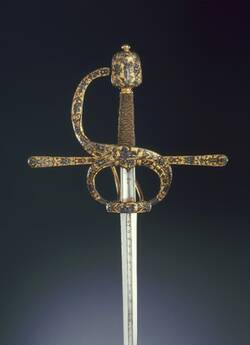The term “rapier” comes from the French rapière. In Spanish, an espada ropera is a sword worn as part of a uniform. The actual origin of the rapier, however, was in Italy, where this specific type of sword emerged in the mid-sixteenth century. As the Spanish term suggests, rapiers were often worn together with a dagger as part of ceremonial dress. The rapier, however, was expressly reserved for the use of knights. Only princes and noblemen were permitted to carry one or to authorise one of their subjects to do so. The rapier you see here, No. 6, with a dagger, belonged to the Elector Christian I “. . . with its carved images and foliage, gilded and coloured metal, it was purchased by my gracious Elector from Othmar Wetter, cutler, here in Dresden, on 22 August, 1590.”
The hilt and the guard are covered with a relief made from elegantly fashioned carved iron. Between the foliage and fabulous creatures – half-animal, half-human – there are medallions. Single figures and whole scenes were depicted on medallions like these. In this case, they are battle scenes. Prominently placed on the hilt is the figure of Marcus Curtius – the Roman hero who prevented a natural disaster by leaping into a fiery crevasse. As soon as he disappeared into the depths with his steed, the earth closed over him and the danger was past.
The amoursmith named in the inventory, Ottmar Wetter, was from Munich. He spent some time at the Court of Saxony, where he worked for the Electors. We know that on 21 April, some six months after Christian I ordered this set, he received his year’s salary of 200 talers.
We also know who made the most artistic item in this group, No. 5 – a rapier that belonged to Christian II. It was Daniel Sadeler, a cutler from Munich who worked for the Imperial court in Prague and for the Duke of Bavaria. This rapier comes from Prague and was a gift from the Emperor Rudolf II to the Elector of Saxony in 1610. The hilt and guard are decorated with fruits, female grotesques and masks. Fortuna, the Roman goddess of Good Luck, takes pride of place on the hilt. Like a goddess of victory, she strides towards the viewer with two wings at her feet, like trophies, and flowers in her hands. The design is in fact based on an etching by Etienne Delaune, a sixteenth-century French engraver.
